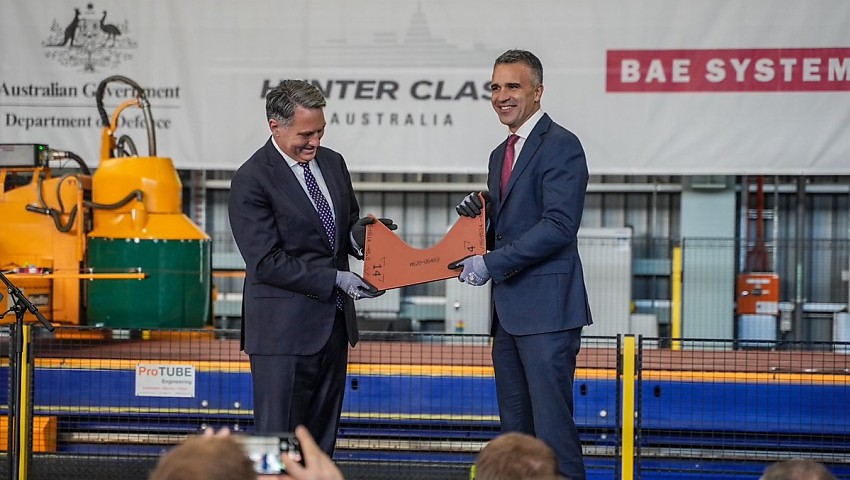Deputy Prime Minister and Defence Minister Richard Marles and South Australian Premier Peter Malinauskas officially cut the first steel for the lead ship of Australia’s Hunter Class frigates, the future HMAS Hunter.
Taking place at BAE Systems Australia’s shipyard in Osborne, South Australia, this program milestone marks a major step forward for the embattled multi-billion frigate program first announced in 2018.
The contract for the construction phase for the first three Hunter Class frigates has now been signed by Defence and BAE Systems Australia, with the first Hunter Class frigate expected to be operational in 2034.
Construction of the Hunter Class frigates will take place at the Osborne Naval Shipyard as part of the Albanese government’s commitment to continuous naval shipbuilding in South Australia.
This comes following a decision earlier this year by the Albanese government to reduce the originally nine planned Hunter Class frigates to a fleet of six to be built in South Australia as part of a broader reconfiguration and reprioritisation of the Royal Australian Navy’s surface combatant fleet.
The construction phase of the Hunter Class Frigate Program will run for 20 years and at its peak, this program will support around 3,000 direct jobs and will support a further 5,000 indirect jobs across the Australian supply chain.
Deputy Prime Minister Richard Marles said, “This first milestone is not just about cutting steel; we are supporting Australian workers to build frigates in an Australian yard, supporting Australian industry.”
These jobs are in addition to the thousands of highly skilled workers that will be required to build our AUKUS submarines and extend the life of the Collins Class submarines, both of which will also take place at Osborne in South Australia.
“This milestone exemplifies our government’s commitment to deliver continuous naval shipbuilding in South Australia and a future made in Australia, by Australians,” the Deputy Prime Minister added.
South Australian Premier Peter Malinauskas said, “The construction of the frigates locks in a pipeline of continuous naval shipbuilding in South Australia, delivering thousands of secure, well-paid jobs for generations to come. This delivery of frigates alongside SSN-AUKUS submarines puts South Australia front and centre in the most crucial of national endeavours.”
The Hunter Class frigates are a key component of the Albanese government’s commitment to ensure the Royal Australian Navy has a surface fleet with high levels of lethality and deterrence in a time of increased global uncertainty.
“It also represents a step change in our state’s economic complexity, which will help improve the standard of living for South Australians more broadly,” Premier Malinauskas said.
Ben Hudson, Chief Executive Officer, BAE Systems Australia, said, "This is a proud moment for all of us at BAE Systems Australia and it comes at a time when the capability of Hunter has never been more important. Hunter will be one of the most technologically advanced, stealth-capable anti-submarine warfare vessels in the world and its modular mission bay allows it to undertake a wide-range of missions from warfare to humanitarian and disaster relief."
Mr Hudson's sentiments were echoed by Managing Director, BAE Systems Australia – Maritime, Craig Lockhart who added, "We already have a head-start on the construction of the first Hunter class frigate, with six schedule protection blocks already in production approved under the design and productionisation phase as part of the risk mitigation strategy.
"This program has always been more than just building ships, we have created world-leading facilities, a vibrant supply chain ready to step up to full rate of production and a workforce that is proving it can produce the highest quality shipbuilding products that can compete anywhere," Mr Hudson added.
The Royal Australian Navy’s six Hunter Class frigates are a key component of the Australian government’s commitment to ensure the Royal Australian Navy has a surface fleet with high levels of lethality and deterrence in a time of increased global uncertainty.
Based on the Type 26 Global Combat Ship, the first four of which are under construction at BAE Systems’ site in Glasgow, UK, Hunter is one of the world’s most advanced anti-submarine warfare frigates and will provide the Royal Australian Navy with next-generation capability.


